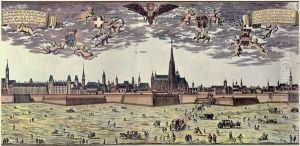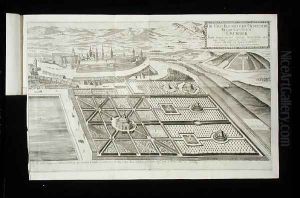Georg Matthaus Vischer Paintings
Georg Matthäus Vischer was an Austrian topographer, cartographer, and engraver, recognized for his significant contribution to the mapping and depiction of the Austrian territory in the 17th century. Born in 1628 in Wenns, now part of modern-day Austria, Vischer’s early life and education are not extensively documented, but his work suggests a thorough training in engraving and cartography, fields that were crucial for the production of maps and topographical representations at the time.
Vischer's most notable contribution to cartography and topography is his atlas, 'Topographia Archiducatus Austriae Inferioris Modernae', published in 1672. This atlas offers a detailed view of Lower Austria, featuring maps and views of towns, monasteries, and castles, and is considered a masterpiece of baroque cartography. His work is valued not only for its artistic quality but also for its historical significance, providing insights into the landscape, architecture, and settlements of 17th-century Austria.
In addition to his atlas, Vischer produced a variety of other works, including maps of other regions, religious engravings, and portraits. Despite the challenges of his era, such as limited surveying techniques and the political complexities of the time, Vischer’s work is remarkably accurate and detailed, reflecting his dedication to his craft and his skill as an engraver and cartographer.
Georg Matthäus Vischer's contributions extended beyond his own publications. He influenced the field of cartography in the Austrian territories and the broader Habsburg empire. His detailed representations of landscapes, buildings, and settlements have provided a valuable resource for historians, geographers, and art historians, offering a window into the visual and cultural landscape of 17th-century Austria. Vischer passed away in 1696, leaving behind a legacy that would endure in the annals of cartographic history and continue to be celebrated for its artistic and historical value.


